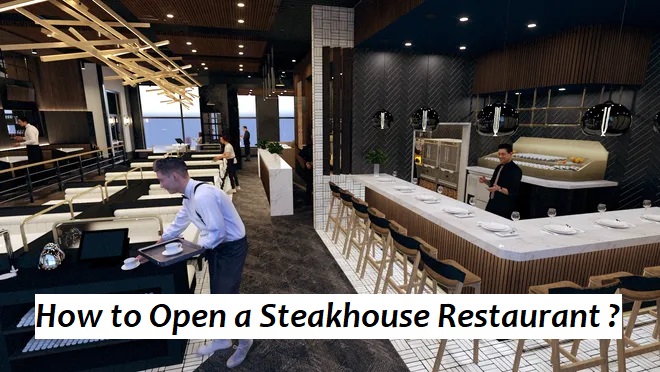Are you dreaming of opening your own steakhouse restaurant? Do you have a passion for cooking and a love for serving delicious, high-quality steaks to customers? Opening a steakhouse restaurant can be a fulfilling and lucrative venture, but it requires careful planning and execution. In this comprehensive guide, we will walk you through the essential steps to open a successful steakhouse restaurant. From market research to managing finances, we will cover all the key factors that go into starting a steakhouse restaurant. So let’s get started!

Steps to Open a Steakhouse Restaurant
Opening a steakhouse restaurant is not just about cooking great steaks; it involves a series of steps that must be followed to ensure a smooth and successful launch. Here are the key steps that aspiring entrepreneurs should take when opening a steakhouse restaurant:
Market Research
The first step in opening a steakhouse restaurant is conducting thorough market research. This involves identifying market opportunities, understanding your target audience, analyzing competitors, and staying updated on industry trends. Market research will help you determine if there is a demand for a steakhouse restaurant in your area and what type of customers you should cater to.
To conduct market research, you can start by surveying potential customers in your area to gather insights on their dining preferences, budget, and expectations from a steakhouse restaurant. You can also visit other steakhouse restaurants in your area to observe their operations, menu offerings, and pricing strategies. Additionally, researching online reviews and ratings of existing steakhouse restaurants can provide valuable information about customer satisfaction and areas for improvement.
Creating a Business Plan
A comprehensive business plan is crucial for the success of any restaurant, including a steakhouse. It serves as a roadmap for your restaurant’s operations, financial projections, and marketing strategies. Your business plan should include a detailed description of your restaurant’s concept, target market, menu offerings, pricing strategy, and competitive advantage.
In addition to outlining your restaurant’s operations, your business plan should also include a detailed financial plan. This should cover the initial investment required to open your steakhouse restaurant, projected revenue and expenses, and expected profitability. A well-crafted business plan will not only help you secure funding from investors or lenders but also serve as a reference point for decision-making throughout the launch and operation of your restaurant.
Legal Requirements
Before opening a steakhouse restaurant, it is essential to comply with all legal requirements set by your local and state authorities. These may include obtaining necessary permits and licenses, registering your business, and acquiring insurance coverage. Failure to comply with these regulations can result in hefty fines or even the closure of your restaurant.
To ensure that you have met all legal requirements, it is advisable to consult with a lawyer who specializes in restaurant businesses. They can guide you through the process and help you avoid any legal complications down the line.
Key Factors for Opening a Successful Steakhouse Restaurant
Now that we have covered the essential steps to open a steakhouse restaurant let’s dive deeper into some key factors that can contribute to the success of your restaurant.
Cost Breakdown for Opening a Steakhouse Restaurant
Opening a steakhouse restaurant requires a significant initial investment. The cost breakdown can vary depending on factors such as location, size, and menu offerings. Here is a rough estimate of the costs involved in opening a steakhouse restaurant:
| Expense | Estimated Cost |
|---|---|
| Rent and Utilities | $5,000 – $10,000 per month |
| Kitchen Equipment | $50,000 – $100,000 |
| Furniture and Decor | $20,000 – $30,000 |
| Initial Inventory | $10,000 – $15,000 |
| Marketing and Advertising | $5,000 – $10,000 |
| Staff Salaries | $10,000 – $15,000 per month |
| Legal and Insurance Fees | $5,000 – $10,000 |
It is crucial to have a detailed budget in place to ensure that you have enough funds to cover all the necessary expenses. You may also consider seeking funding from investors or applying for a small business loan to cover some of these costs.
Legal Requirements for Opening a Restaurant in Seattle
If you plan on opening a steakhouse restaurant in Seattle, there are specific legal requirements that you must comply with. These include obtaining a food establishment permit from the Seattle-King County Public Health Department, registering your business with the Washington State Department of Revenue, and acquiring insurance coverage for your restaurant.
Additionally, Seattle has strict regulations regarding food safety, sanitation, and waste management. It is essential to familiarize yourself with these regulations and ensure that your restaurant meets all the necessary standards to avoid any penalties or closures.
Market Research for Opening a Steakhouse Restaurant
Market research is a crucial step in opening a successful steakhouse restaurant. It helps you understand your target audience, identify market opportunities, and stay updated on industry trends. Here are some key factors to consider when conducting market research for your steakhouse restaurant:
- Target Audience: Determine who your ideal customers are based on factors such as age, income level, and dining preferences. This will help you tailor your menu offerings, pricing strategy, and marketing efforts to attract and retain your target audience.
- Competition: Research other steakhouse restaurants in your area to understand their operations, menu offerings, and pricing strategies. This will help you identify gaps in the market and differentiate your restaurant from competitors.
- Industry Trends: Stay updated on current trends in the restaurant industry, particularly in the steakhouse segment. This can include popular cuts of meat, cooking techniques, and menu innovations. Incorporating these trends into your restaurant can help attract customers and keep your menu fresh and exciting.
Creating a Business Plan for Your Steakhouse Restaurant
As mentioned earlier, a comprehensive business plan is crucial for the success of your steakhouse restaurant. It serves as a roadmap for your operations, financial projections, and marketing strategies. Here are some key elements that should be included in your business plan:
- Restaurant Concept: Describe your restaurant’s concept, including its theme, atmosphere, and target market.
- Menu Offerings: Outline your menu offerings, including appetizers, entrees, sides, and desserts. Be sure to include any signature dishes or unique twists on traditional steakhouse fare.
- Pricing Strategy: Determine how you will price your menu items based on factors such as ingredient costs, competition, and customer expectations.
- Marketing Strategies: Develop a marketing plan that outlines how you will promote your restaurant to potential customers. This can include online platforms, social media, public relations, and partnerships with other businesses.
- Financial Projections: Create a detailed financial plan that includes projected revenue, expenses, and profitability for the first few years of operation. This will help you track your progress and make informed decisions to ensure the financial stability of your restaurant.
Choosing the Right Location for Your Steakhouse Restaurant
The location of your steakhouse restaurant can significantly impact its success. When choosing a location, consider factors such as visibility, accessibility, and proximity to your target market. Here are some tips for selecting the right location for your steakhouse restaurant:
- High Visibility: Look for a location that offers high visibility, preferably on a busy street or in a popular shopping area. This will help attract customers and increase foot traffic to your restaurant.
- Accessibility: Ensure that your restaurant is easily accessible by car and public transportation. This will make it easier for customers to reach your restaurant and increase the chances of repeat visits.
- Target Market: Choose a location that aligns with your target market. For example, if you are targeting high-income customers, consider opening your restaurant in an affluent neighborhood.
Hiring and Training Staff for Your Steakhouse Restaurant
The success of your steakhouse restaurant will depend on the quality of your staff. It is crucial to recruit and train a team of experienced chefs, servers, and support staff to ensure excellent service and food quality. Here are some tips for hiring and training staff for your steakhouse restaurant:
- Recruiting: Look for candidates with previous experience in the restaurant industry, particularly in steakhouse restaurants. They should have a passion for cooking and serving high-quality steaks and be able to work well under pressure.
- Training: Develop a comprehensive training program for all staff members to ensure consistency in service and food quality. This can include teaching them about your restaurant’s concept, menu offerings, and customer service standards.
- Teamwork: Encourage teamwork among your staff to ensure smooth operations and a positive work environment. This will also help improve communication and collaboration between different departments.
Marketing Strategies for Your Steakhouse Restaurant
Effective marketing strategies are essential for attracting customers to your steakhouse restaurant. With the rise of social media and online platforms, there are various ways to promote your restaurant to potential customers. Here are some marketing strategies to consider for your steakhouse restaurant:
- Online Platforms: Create a website for your restaurant where customers can view your menu, make reservations, and learn more about your restaurant’s concept. You can also use online platforms such as Yelp, Google My Business, and TripAdvisor to reach a wider audience.
- Social Media: Utilize social media platforms such as Facebook, Instagram, and Twitter to engage with potential customers and promote your restaurant. You can share photos of your dishes, post updates about special events or promotions, and interact with followers.
- Public Relations: Partner with local media outlets to generate buzz about your restaurant. This can include hosting a media event, offering complimentary meals to food bloggers or influencers, and sending out press releases.
- Partnerships: Collaborate with other businesses in your area to reach a wider audience. This can include partnering with hotels, event planners, or local attractions to offer special packages or discounts to their customers.
Managing Finances for Your Steakhouse Restaurant
Establishing a sound financial management system is crucial for the success of your steakhouse restaurant. It will help you track revenue, expenses, and profitability to ensure financial stability. Here are some tips for managing finances for your steakhouse restaurant:
- Accounting Software: Invest in accounting software to help you track all financial transactions accurately. This will also make it easier to generate financial reports and monitor your restaurant’s performance.
- Budgeting: Create a detailed budget that outlines all expected expenses and projected revenue. This will help you stay on top of your finances and make informed decisions to improve profitability.
- Inventory Management: Implement an inventory management system to track ingredient costs and prevent wastage. This will help you control food costs and maintain consistent quality in your dishes.
- Regular Financial Reviews: Conduct regular reviews of your restaurant’s financial performance to identify areas for improvement and make necessary adjustments.
Conclusion
Opening a steakhouse restaurant may seem like a daunting task, but with careful planning and execution, it can be a rewarding and profitable venture. By following the steps outlined in this comprehensive guide, you can set yourself up for success and create a memorable dining experience for your customers. Remember to conduct thorough market research, create a comprehensive business plan, comply with legal requirements, choose the right location, hire and train a skilled team, implement effective marketing strategies, and manage your finances carefully. With dedication, hard work, and a passion for serving delicious steaks, you can turn your dream of owning a steakhouse restaurant into a reality.

Related Posts: